by Wanda Sabir
Happy New Year!
Happy Birthday to my granddaughter Brianna, niece Wilda and friend Fred T.
I am still smiling about America’s new relationship with Cuba and the freed Cuban 5.
If you are in New Orleans (NOLA), don’t miss “Prospect 3: Notes for Now,” the biennial there being celebrated throughout the city through Jan. 25, http://www.prospectneworleans.org/ (more below).
Lower Bottom Playaz at The Flight Deck, 1540 Broadway, Oakland, through Jan. 3
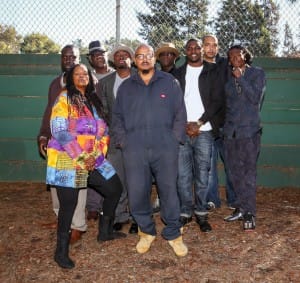
The Lower Bottom Playaz end Season 14, Aluta Continua, with the production of “Jitney,” the eighth installment in The American Century Cycle by August Wilson. Purchase tickets now to join them at their brand new venue in uptown Oakland, The Flight Deck, 1540 Broadway.
A limited number of Chef’s Tables are available that seat you on stage and grant guests early seating with complimentary wine and cheese platters. For ticket prices and show dates, visit www.lowerbottomplayaz.com. General admission is $15. Shows are 7 p.m. on Friday and Saturday plus 2 p.m. matinees on Saturday and Sunday. The box office opens at 6:40. Bring confirmation of purchase. Reservations are strongly suggested. Call 510-332-1319 and leave message or email wordslanger@gmail.com to make a reservation.
And Still I Rise: A Tribute to Maya Angelou, 1-4 p.m., Saturday, Feb. 7
The West Oakland Branch of the Oakland Public Library’s Annual African American Celebration Through Poetry is celebrating 25 years of continuous poetic performance, ritual, dance and singing expressive of Oakland’s African American community, especially West Oakland’s rich poetic tradition. We are proud to dedicate our 25th Anniversary Celebration to renowned poet Maya Angelou and to Arnold White, West Oakland artist. Both made their transitions in 2014.
Ms. Angelou was an American author, poet, dancer, and singer. She published seven autobiographies, three essay collections and several books of poetry. She was also credited with a list of plays, movies and television shows spanning over 50 years. May 28, 2015, marks the first anniversary of her death. We are proud to dedicate our 25th Anniversary Celebration to Ms. Angelou.
We are proud to dedicate our 25th Anniversary Celebration to renowned poet Maya Angelou and to Arnold White, West Oakland artist. Both made their transitions in 2014.
Arnold White shared his lovely mixed media work with us for over 10 years. Among his many pieces were “Freedom Tree 1 and 2” and “Saxman Uptown.” His work was on banners along San Pablo Avenue announcing the Golden Gate Library Summer Jazz Series for many years. One of his pieces, “Piano Man,” was in Spike Lee’s film “Crooklyn.”
His Galleria in North Oakland on Shattuck Avenue was the site of the yearly Poetry Celebration after-party, where we’d relax with his art, eat and talk. One never grew tired of his stories of home, his parents, the Negro League Baseball games on Sundays, stories of the first Black doctor, McClymond’s High School, his alma mater, and people down and out.
The retired postman and artist was a great supporter of the antiapartheid movement and contributed his work to numerous fundraisers. I remember when he started writing poetry to share with the work he brought each year. “Bag Lady” was the name of his first piece.
This event is organized annually by local author and professor Wanda Sabir, who will also be reading her work. For those poets interested in participating in the celebrations as featured writers, please call 510-238-7352, email 25thannivcelebratingaapoets@gmail.com or come by 1801 Adeline St.. There will be a rehearsal Saturday, Jan. 31, 10 AM -12 Noon. The OPL is not doing a mailing any longer. If anyone is interested in doing funds for such, helping with getting the word out – there will be fliers. Let us know.
Theatre: ‘Tree’ at SF Playhouse Jan. 20-March 7
The notion of home and roots has a thematic edge in America, given the psychic unrooted or uprootedness of its historic landscape. Here the ground does speak, the sky holder of vast memories drunken legacies omit on purpose. Julie Hébert’s “Tree” is another such exploration. In this case, the playwright mines a personal tale to explore a thread hidden in letters inherited from a father. Who was this mystery woman who made Didi Marcantel’s father so happy?

In tales with Southern roots one just follows the melanin, which is what this Caucasian professor of gender studies at LSU in Baton Rouge does. The road takes her to one of the homes of the blues, Chicago, where she meets her “brother” Leo who has moved in with his mother to take care of her. In their search for the truth, these siblings must navigate the fragmented memories of Leo’s aged mother, Mrs. Jessalyn Price, retired school principal, to discover where their roots intersect.
Winner of the Pen Award for Drama and Backstage Garland Award, “Tree” is the story of three generations divided by race, culture and time. The play has contemporary resonance, posing questions about family and what it means to “be related.” “I set out to write a play about race and ended up writing a play about family,” said playwright Julie Hébert about “Tree.”
I had a lovely conversation with Julie Hébert and actors Carl Lumbly and Susi Damilano, producing director and co-founder of San Francisco Playhouse. I believe this will be the first time the two actors have been on stage together in their roles as siblings. Jon Tracy directs “Tree” after completing a successful production locally at the Aurora Theatre in Berkeley. The riveting work, playwright Fraser Grace’s “Breakfast with Mugabe,” starred L. Peter Callender as Mugabe and Leontyne Mbele-Mbong as Grace Mugabe, Adrian Roberts as the president’s bodyguard, Gabriel, and Dan Hiatt as Andrew Peric, the white Zimbabwean psychiatrist. With such a recent success locally, fans will probably follow him to his new gig across the Bay.
“Tree” goes up Jan. 20 to March 7, opens Jan. 24, 2015. Tuesday, Wednesday, Thursday performances are at 7 p.m., Friday and Saturday 8 p.m. and matinees Saturday 3 p.m. and Sunday 2 p.m. For tickets, which are $20-$120, or more information, contact San Francisco Playhouse box office at 415-677-9596 or visit www.sfplayhouse.org.
‘Annie,’ the movie
With a Black child in its starring role, “Annie,” which was on Broadway and remade a couple of times into a movie, stars this little girl with an Afro, freckles and spunk – yes even before Quvenzhané Wallis in the current starring role. Wallis’ “Annie Bennett,” who lives in Harlem with a drunken guardian, Colleen Hannigan (Cameron Diaz), and other unlucky foster care sisters, has spunk and smarts. She sees some boys chasing a stray dog and she chases the boys away and rescues the dog. On her way back, she almost gets hit by a truck, except for Will Stacks’ (Jamie Foxx’) presence of mind. He grabs her out of its path, tells her to be careful and the two go their separate ways.
Someone films this act of kindness and it goes viral. Will Stacks’ people look for Annie as an angle to boost the cell phone tycoon’s campaign for mayoral office. Of course it develops into a lot more. Stack’s secretary Grace Farrell (Rose Byrne) finds the 10-year-old Annie, who is looking for the other piece of the heart necklace she arrives with at her foster placement; it’s a clue. Her other clue is that her parents loved to eat at an Italian restaurant. So she visits this restaurant weekly to see if they have returned for her.

Broken hearts as metaphor take on new meaning here, as do the multiple love stories – primary of course is Annie’s and all the foster girls who want a family, parents to love them. The other love stories look at how deep down inside love connects us all, even across racial lines – OK OK, this is a movie and interracial sells. Ask Henry Louis Gates Jr. (smile). So we have big bucks Will with Grace along with Colleen and the Lou (David Zayas), a bodega owner who befriends Annie and sends flowers with her to her foster mother.
There is a bad guy who teams up with Colleen, Guy (Bobby Cannavale), who is Will Stacks’ media campaign manager. Guy takes evil to another level.
All the songs from the Broadway musical are back with a new choreography and visual enhancement. “It’s a Hard Knock Life” is one of them – there are overtones of “Stomp!” in this rendition with brooms and buckets. Another showstopper is the opening and closing tune, “Maybe,” and Wallis’ solo, “Opportunity.” “You’re Never Fully Dressed Without a Smile” is a nice anthem. “Little Girls” is a creative masterpiece. I seem to be the only one who thinks director Will Gluck and Zach Woodlee, choreographer, do a marvelous job with the story.
It is a lovely film. One older couple gave it an unsolicited “10” when Bree and I were in line for tickets the first day of Kwanzaa – Umoja (unity). For those who enjoyed Wallis in “Beasts of a Southern Wild,” you will love the older child in this role – she sings and dances too (smile). There is a kidnap, a chase, a rescue and a commentary on “literacy”– all this with spoons and spoons full of sugar.
Broken hearts as metaphor take on new meaning here, as do the multiple love stories – primary of course is Annie’s and all the foster girls who want a family, parents to love them.
Perhaps what makes this tale so apt as the updated Daddy Warbucks character, cell phone tycoon Stacks, who grew up in Queens also orphaned early in life when his dad died while he was younger. Both Stacks’ and Bennett’s characters show that adults need children as much as children need adults. It is a two-way street. Work and money and material success cannot hide a malfunctioning heart. As in the cartoon 1924 comic strip “Little Orphan Annie“ by Harold Gray updated for screen here, Stacks and Bennett both win.
This might be the only favorable review – NYT and Vanity Fair gave it a thumbs down while both articles agree that Wallis and Foxx are great (smile). Produced by the power team: Will Smith, Jada Pinkett Smith, Shawn “Jay-Z” Carter and others.
In Memorial
If you live long enough the goodbyes come frequently. I said farewell to many beloved last year, Cousin Suzy, Uncle Gerard, Arnold White, Alonzo Fields, Fred Ho, Yuri Kochiyama, Dr. Chinosole, Karl Rogers, Imamu Amiri Baraka …
Dr. Chinosole sort of slipped by quietly, so if you missed her … you were not alone. I remember her “Schooling the Generations in the Politics of Prison” (1996) collection of powerful writing. I always felt the weight of her brilliance. I also loved her book, “African Diaspora and Autobiographics: Skeins of Self and Skin” (2001), on the African American narrative tradition, our gift to American letters. It is a genre we perfected with the slave narratives to the classics “Narrative in the Life of a Slave” by Frederick Douglass and “Up From Slavery” by Booker T. Washington, not to mention Harriett Jacobs’s “Incidents in the Life of a Slave Girl.”
Dr. Chinosole sort of slipped by quietly, so if you missed her … you were not alone. Dr. Chinosole’s memorial service is Jan. 4, 1 p.m., at 550 24th St. in Oakland.
She is remembered by her colleagues at San Francisco State University, where she taught after chairing the Women’s Studies Department before her retirement as “a groundbreaking scholar-activist of the African Diaspora with an emphasis on Black feminist theory and literature and autobiography and the prison industrial complex. …
“A supporter of the SF State strike of 1968, shortly thereafter she became one of the first Black Studies professors at SFSU and in 1970 she served as the first acting director of what is now the College of Ethnic Studies. She received her PhD in Comparative Literature from the University of Oregon in 1986. In 2011-12, she was a visiting research fellow at the University of Victoria, where – after studying autobiography for much of her career – she was at work on her own autobiography.” I hope someone has her notes.
Dr. Chinosole’s memorial service is Jan. 4, 1 p.m., at 550 24th St. in Oakland. The foregoing is taken from http://wgsdept.sfsu.edu/chinosole-emerita.
In the Name of Love: MLK Tribute 2015, Sunday, Jan. 18, 7 p.m., Scottish Rite Center, 1547 Lakeside Drive, Oakland
This year is a Celebration of Outstanding Achievements of Bay Area African American Female Artists, who include Ms. Faye Carol, Linda Tillery, Gina Breedlove, Melanie DeMore with Tammy Hall on piano, Kofy Brown on bass and Ruthie Price on drums, plus the Oakland Interfaith Gospel Choir with director Terrance Kelly and Oakland Children’s Community Choir with director Melanie DeMore. The event is hosted by Dana King. For more information, visit http://mlktribute.com/.
Blood at the root: ‘Selma’ (2014) and ‘Lord Selma’ (1999)
I borrowed the film “Selma, Lord Selma” (1999) to get in the mood for “Selma,” coming out in time for Martin King’s birthday. Yolanda King (Miss Bright) is in this film as 7-year-old Shyanne Webb’s (Jurnee Diana Smollett-Bell’s) teacher. Smollett-Bell fans will love meeting her as a youngster in this work. I hadn’t known before watching the film that the characters portrayed were real people, some, like Mrs. Webb and Mrs. Rachel West (actress Stephanie Zandra Peyton), her best friend and next door neighbor, still live and work for freedom and justice in Alabama. Others, like youth organizer Jimmie Lee Jackson (actor Zach Rogers) and Jonathan Daniels (actor Mackenzie Astin), a young seminary student who traveled to Alabama to register people to vote, highlight how ordinary Black people and whites were drawn to the movement for freedom for Black Americans.
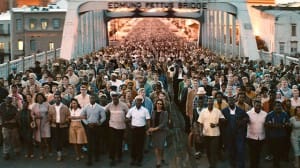
It also shows how dangerous it was for Black families and how much courage it took to stand up rather than tolerate the abuse. For Shyanne, freedom was worth the ultimate sacrifice. She reflects on this time 50 years ago in a taped interview after the film. She recalls meeting King at a planning meeting for adults, where she is invited up to meet him and told “freedom” was what they were after.
An excited Shyanne joins the movement and gives it priority over school, over everything. Even after the failed attempt to cross the Edmond Pettus Bridge, eyes burning from tear gas, she does not waver. And when she can see again, the little girl writes her obituary (just in case), then goes by the church to see if she can help. Her stirring song, Black America’s Battle Cry for the Republic, “I Ain’t Gonna Let Nobody Turn Me Around,” soon has everyone who can stand on his and her feet. Watch https://www.youtube.com/watch?v=cBQu1BWdpiY.
What an amazing girl!
In the film, John Webb (actor Afemo Omilami), Shy’s father, tells the story of losing his eldest to the movement. She had had to leave town or risk losing her life. Now here was her younger sister doing to the same thing (smile). The events of Selma were not much different from the events of today – domestic terrorism on Black people. “What do we want?” King asks the girls in the film. “Freedom,” they shout, even after the young girl loses two dear friends, Jimmie Lee and Jonathan, to violence.
Based on a book co-authored by the two women, the film is directed by Charles Burnett. I wonder how David Oyelowo will hold up against so many fine performances of Dr. King, like Clifton Powell’s in this historic retelling and Adrian Robert’s performance in Katori Hall’s “Mountaintop” at Theatre Works. Directed by the very capable Ava DeVernay, I am sure he will be stellar (smile). He was in her “Middle of Nowhere,” the wonderful film about the effects of prison on those outside its walls. His role as Louis Gaines in Lee Daniel’s “The Butler” was stunning. If you recall the film, he was the rebellious questioning son, who challenges his father’s acceptance of racism. Certainly it pays to know the director, look a bit like the principle character, in this case Dr. King, and have strong acting skills (smile).
DeVernay doesn’t play; the ensemble is stellar. What I found amazing is that since the director could not get permissions from a 2009 King estate license of his speeches to DreamWorks and Warner Bros. for an untitled project to be produced by Steven Spielberg, she rewrote them, paying attention to the stylistic nuances that make King a master orator. I hope to get to talk to her about this and the Paul Webb story (2008, screenwriter) which seemed to garner interest from its inception in 2008 through multiple production hands including Lee Daniels (2010) to current producer Oprah Winfrey and Brad Pitt (Plan B Entertainment 2013) who hired DeVernay along with Pathe (also in 2013).
Jason Moran composed the soundtrack, his first time for film. John Legend and Common, who portrays James Bevel, released “Glory” (for Ferguson) in December.
Art at MoAD
“Drapetomania” showcases artistic works by the Grupo Antillano, the name given to an outstanding group of artists in the 1970s and ‘80s. The exhibition offers a revisionist understanding of the “new art of Cuba” and focuses on the work of artists who celebrated the importance and significance of Africa and its influence on Cuban culture and national identity. The exhibit is at the Museum of the African Diaspora through Jan. 4. For information, call (415) 358-7200 or visit http://moadsf.org.
Also at MoAD is Lava Thomas’s “Beyond” Dec. 3, 2014 through April 12, 2015. On exhibit Jan. 16-April 5 is “The Art of Elizabeth Catlett.”
Annual African Film Festival 2015 at UC Berkeley Art Museum, Pacific Film Archive
Kathy Geritz, film curator, states about PFA’s African Film Festival, “Liberation movements in Africa – both today and in the past – are a focus of this year’s edition of our annual African Film Festival. The prodemocracy protests in Egypt’s Tahrir Square and the aftermath of civil unrest in Kenya are brought to life in two nuanced narrative films, ‘Winter of Discontent’ by Ibrahim El Batout and ‘Something Necessary’ by Judy Kibinge.
“The struggles for independence decades earlier in Angola, Guinea and Cape Verde are urgently told in Sarah Maldoror’s little-known politically committed films from the late ‘60s and early ‘70s, presented as part of our special two-evening tribute to one of the first women to make films in Africa. Maldoror believes that ‘to make a film means to take a position.’ For ‘Sambizanga,’ which she made after working on Pontecorvo’s ‘Battle of Algiers,’ Maldoror involved nonprofessional actors who were active in anticolonial movements. In ‘Cassa Cassa!’ Elodie Lefebvre explores African history through dance. She documents an inspiring cultural exchange between choreographers, dancers and musicians from throughout Africa and its diaspora who gather to share their own practice as well as illuminate its links to traditional dances.
“This year’s festival richly represents women filmmakers, including three short narratives by a new generation. Join us for this tour of Africa and the African diaspora and discover both new and historical voices. Also of interest is our Afterimage series with French filmmaker Mati Diop, who works in both France and Senegal.”
Pacific Film Archive Theater is located at 2575 Bancroft Way, Berkeley. For information, call 510-642-1124. For tickets, call 510-642-5249. Visit http://bampfa.berkeley.edu facebook.com/bampfa. General admission is $9.50 for one program, $13.50 for double bills. BAM/PFA members, children, UC Berkeley students, faculty and staff pay $5.50 and $9.50. Other students, young people (13-17), seniors and disabled persons pay $6.50 and $10.50.
Prospect New Orleans, or P.3
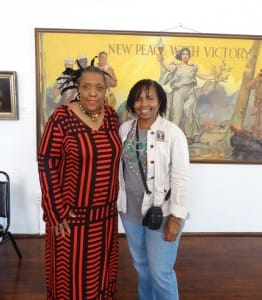
I was in New Orleans for the related conference, “Flash of the Spirit,” honoring the 30th anniversary of the publication of Robert Farris Thompson’s book by the same title. Dr. Thompson wasn’t able to join us at the Ogden Museum of Southern Art in person; he was recovering from triple bypass surgery. He did join us by Skype for a short lecture on Papa Legba.
Scholars were at the two-day conference from throughout the county and world discussing topics ranging from boxing to ritual in cinema to why we eat black-eyed peas – the gods we evoke gastronomically (a literal reading or should I say taste for “soul” food.) It was great to see Pan African people and others illustrate how much of our African heritage we still embody. New Orleans, the most African city in the country – or so it is said – was the perfect venue for this discussion (smile).
The day after the conference, I did a bit of museum hopping, first The George and Leah McKenna Museum of African American Art to see Carrie Mae Weems multimedia installation, “Lincoln, Lonnie, and Me – A Story in 5 Parts” (2012), where “featured individuals from the past and the present appear as holograms in a re-creation of “Pepper’s ghost,” a 19th-century illusion. As jazz music drifts through space, ghostly figures emerge from red curtains drawn across a stage, telling stories of race, class and gender. Characteristic of Weems’s practice, the manifestations do not intend to be representative of the Black body, the female body or any other narrowly defined stereotype, but aim instead to articulate subjectivity.

The characters address the viewers directly, transposing them from passive onlookers into active subjects. The piece embodies the underlying premise of Weems’s entire oeuvre – inspiring viewers to continue asking themselves where they came from, who they are and aspire to be, and whom they love.” On the floor below is a collection of Weems’s photography – she is posed in front of NOLA architecture, a factory, an antebellum house. Other photos were from “Missing Link Sheep, 2003.” The artist had on tuxes with animal or fowl heads.
Before I leave, I meet Cherise Harrison, whose family has a museum honoring the Mardi Gras Indian tradition, named for her father Donald Harrison Sr. She tells me about the exhibit, featuring women chiefs in their regalia. I ask her about her red and black dress and she tells me about Papa Legba and the jazz funeral she attended that morning. People traditionally wear red and black or all white. I take a photo of her with Big Chief Darryl Montana.
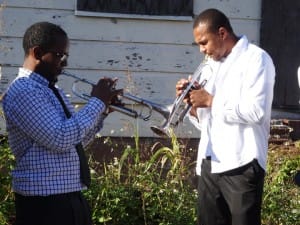
I then drive up the street to Ashé Cultural Arts Center to see Kerry James Marshall’s site specific “image bank” of art history. Marshall’s site-specific window installation for P.3 directly addresses this “‘image bank, framing, magnifying and multiplying the African art collection of Ashé Cultural Arts Center with gold-mirrored Plexiglas. The effect is the visually glamorized and Afro-Futurized (re)integration of the surrounding historically Black neighborhood with these signifiers of African Diaspora tradition: To paraphrase Dr. King, the moral arc of the universe is long and it unites the community with its heirs and keepers” (P.3).
That Saturday afternoon, Ashé was hosting a holiday fair with a fashion show. From there I drove to a special performance in the Ninth Ward. It was a part of “Home Court Crawl,” artist Lisa Sigal’s work across four distinct neighborhoods in NOLA. “Though each of these houses has its own story, urban blight remains a mute emblem of the social politics plaguing many of our historic cities. Sigal’s installation of texts from playwright Suzan-Lori Parks’s “365 Days/365 Plays” (2002–3) returns voice to abandoned architecture and urges neighbors to re-see and remember the mnemonic and emotional and social value that still lingers, unseen, among the broken structures. This backdrop was the genesis for creative interpretation and interaction between the artists and the viewers” (P.3).

I knew Frederick “Hollywood” Delahoussaye (poet) from post-Katrina fundraiser report backs – nine or 10 years ago (2005-2015). He teaches youth at Ashé Cultural Center now. It was really cool seeing him perform with dancer, Keisha McKay. At one home, there were no walls under the staircase. A Black woman stood near who has been living under the house for a year now. Stephanie McKee of Junebug Productions spoke about the need for art that sparks conversations like this one before the walk began and at its conclusion. TBC, youthful brass band, led the walk and provided a contextualized backdrop for the very real disappearance of a people (in real time). The second line honored the loss to the community these empty homes represent.
The crawl ended in an empty lot where people were encouraged to stay, have barbecue from “Back of the Truck” eatery (smile) and talk about the social political interruption these lots and boarded up homes represent to New Orleans specifically and to all of us philosophically. I wasn’t able to hang out and talk for long, as I left there for City Park to visit the New Orleans Museum of Art where there were more pieces from Prospect 3, the “Reparations” group show, which features 20-30 artists using small frames (2×5) I wanted to see.
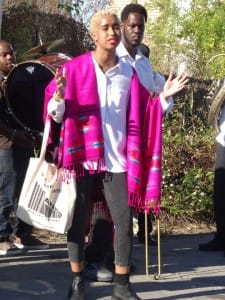
What I really liked though was “America,” artist Will Ryman’s log cabin (as in Abe Lincoln). Unlike the former president’s humble abode, Ryman’s walk-in wooden edifice (built on site) is coated in gold resin. The artist packed the cabin with, among other things, bullets, arrowheads, cotton bolls, chains, sparkplugs, iPhones, lumps of coal. These items have an essence, a vitality which needs no interpretation – let’s say they are occupants.
The visit is a trip down American history lane. You don’t even need to read; the actual items in multiple numbers shining brightly, almost blinding in their brilliance and distaste, say more than any billboard how much Western European’s “Manifest Destiny” cost in human life. Gold was their religion. The fever continued in the West when Mexico lost California – over half its territory – in the Treaty of Guadalupe Hildago in 1848 (500,000 square miles of valuable territory). It put Mexico in a permanent state of underdevelopment and disenfranchisement. Citizenship rights and individual rights to property, promised in the treaty, were all ignored. It was with this acquisition that the United States sealed its superpower status (http://www.pbs.org/kera/usmexicanwar/war/wars_end_guadalupe.html).
“‘Log cabins are an iconic symbol of America, but I didn’t just want a symbol,’” Ryman said in an interview with Chris Waddington of The Times-Picayune. “‘To me it’s important that my cabin is made from real logs and that everything inside it is also real. It’s an appropriated object, a conceptual sculpture, but it’s also a showcase for objects that have a lot of meaning when you gather them in abundance and put them together. I didn’t need to change a thing: the arrowheads and the bullets are sculpted objects, too, forms made for a purpose.’ Ryman coated everything but the coal in the same gold resin, transforming the cabin’s single room into a glittering mosaic sanctum – a space that’s stunningly different from the rustic wood forms of the exterior. For him, the golden cabin is an emblem of the ruling passions of a capitalist society, from the first arrival of Europeans to the advent of the iPhones that frame to cabin’s fireplace” (http://www.nola.com/arts/index.ssf/2013/10/star_sculptor_will_ryman_sets.html).
In my prior visit to NOLA, I got by the Ogden for “Basquiat and the Bayou” and to the Contemporary Art Center New Orleans for P.3, which is simply fabulous – three floors of work by artists from around the world including Cuba. There were a couple of outdoor exhibits best seen after hours in Jackson Square (“You Belong Here”) and LUNA Fête or Light Up NOLA Arts in Lafayette Square – Ogden on Camp Street is in an art center hub. Everything is walking distance – even the famous River Walk stores, Harrah’s Casino and the French Quarter. The Civil War Museum is around the corner and there are lots of galleries. The Black galleries and museums are in the neighborhoods, which means you need to get on a street car or bus (smile).
Bay View Arts Editor Wanda Sabir can be reached at wanda@wandaspicks.com. Visit her website at www.wandaspicks.com throughout the month for updates to Wanda’s Picks, her blog, photos and Wanda’s Picks Radio. Her shows are streamed live Wednesdays at 7 a.m. and Fridays at 8 a.m., can be heard by phone at 347-237-4610 and are archived at http://www.blogtalkradio.com/wandas-picks.





